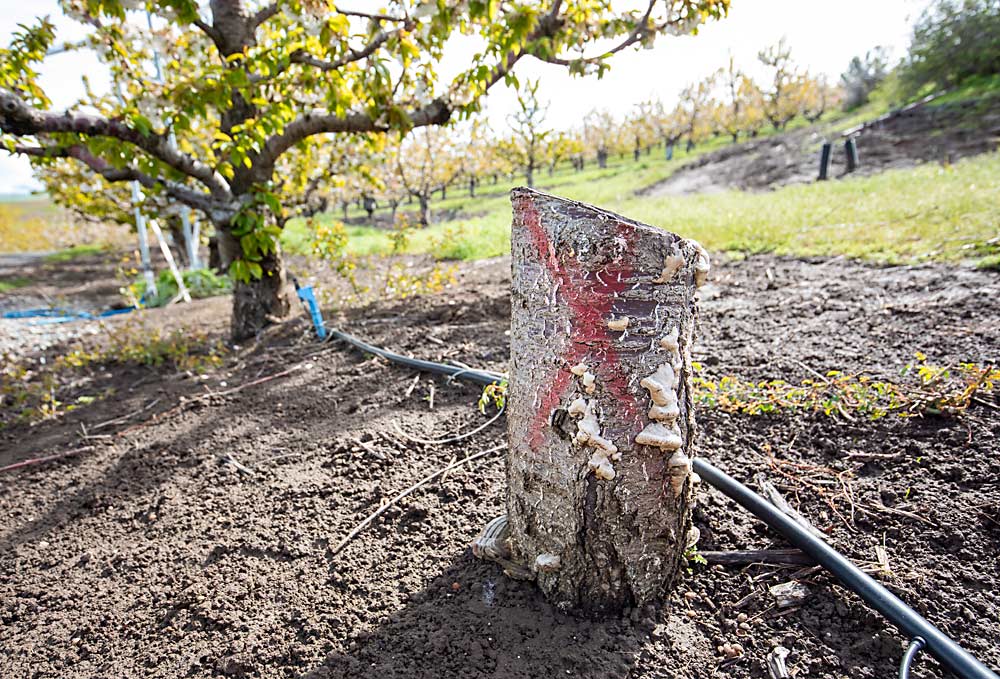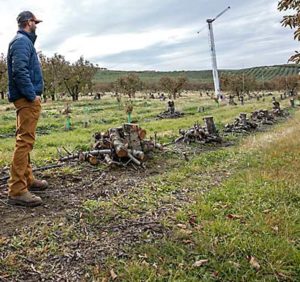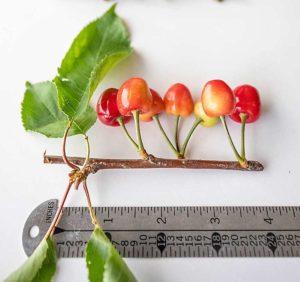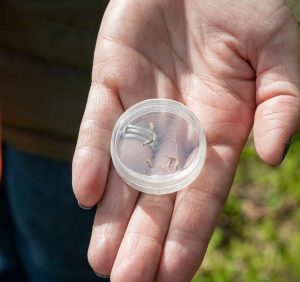
In Devon Wade’s cherry orchard, stumps with red X’s mark where X disease has taken a bite out of his production. Wade marks the trees when he detects symptoms — small, poorly colored and distasteful fruit — just before harvest and then removes the trees afterward, applying an herbicide to the cut stump to kill the roots and check for root-grafting.
Removing infected trees reduces the pathogen source for the leafhopper vectors that spread the disease, and it is the top management advice from Washington State University and Oregon State University, along with spraying for leafhoppers after harvest.
After first noticing the problem in his Sweetheart block in The Dalles, Oregon, in 2018, Wade removed 50 trees in 2019, 25 in 2020 and just three or four last year.
“It is getting better,” he said. “If you get rid of the trees immediately, it’s working.”
Across the wider region, X disease (often referred to under the umbrella term “little cherry disease”) remains a serious threat, driving the removal of hundreds of acres and increasing costs, with added expenses for testing and postharvest leafhopper control programs. But growers dedicated to scouting and removing sick trees report that their efforts are working.
“I sleep a little easier than I did three years ago,” said Phil Doornink, who farms with his father, Jim, in Wapato, Washington. “We do have a handle on it, but I don’t have a good grip on the handle.”
Like Wade, the Doorninks first detected a few symptomatic trees, clustered near an orchard border. Then it was 10 to 15 trees. Then 150. Since they started spraying for leafhoppers after harvest, several years ago, the spread has slowed. Last year, they removed just 15 trees.
Doornink and Wade both credit the scouting efforts of their crews for helping them find infected trees, which at first may show symptoms on only one branch. Doornink said he offers little incentives — such as buying lunch for whoever finds the most — to encourage reporting.
“It takes a lot of eyes out there to see this stuff,” he said.
This year, with the short crop and inconsistent fruit maturity, that might be even harder to do.
“Growers will have to do a lot more testing this year,” said Corina Serban, the little cherry disease specialist with Washington State University Extension. She recommends sending samples to WSU’s plant pathology lab in Pullman, which has grant support to offer growers testing at a reduced rate.
WSU recently released new guidance to help growers interpret test results. Previously, testing was treated as a black-or-white decision, infected or not, but research shows that it takes years for the amount of pathogen to build up in infected trees before fruit symptoms become apparent. The new recommendations reflect that, Serban said, so growers can see if they have an early-stage infection or a serious one.
“It’s hard to tell growers to keep removing trees,” she said. “If you have a lower infection, you can still maybe get another year or two of crop, but if you have a higher infection, keeping those trees is not going to get you any benefit.”
The results from the PCR test come in a range; the lower the number, the more severe the infection. A PCR result ranging from 18 to 23 indicates that the tree has 40,000 or more phytoplasma cells in just the sample tissue, according to the WSU report. Those trees pose a very high risk for transmission.
Test results in the 29 to 35 range indicate the sample had just tens or hundreds of phytoplasma, thus a mild infection that poses less of a transmission risk. Depending on their risk tolerance, growers could continue to monitor and crop those trees until symptoms worsen. (For more details on how to interpret test results, head to: bit.ly/little-cherry-test-numbers.)
In peaches, X disease symptoms tend to show up quicker, including a shot hole pattern in yellowing leaves, said grower Trevor Perrault of Wapato. That makes it easier to scout for sick trees and remove them right away.
“That’s probably part of our success,” he said of their ability to keep young peach blocks healthy despite ongoing infections in nearby orchards.
He also traps for leafhoppers and, when the numbers go up, he starts a spray program every 14 days.
“It keeps our numbers down so we’re not spreading any virus,” he said. The cost? Definitely worth it. “If you are not taking care of things, it’s going to cost you tenfold.”
Doornink also credits his aggressive leafhopper program for reducing disease spread but acknowledges the cost will hit the budget a lot harder this year.
“I could afford to be aggressive the last couple years because we were making money,” he said. This year’s expenses and expected returns look pretty different, but the risk remains. “Even though everything is more expensive this year, the chemicals, the fuel, it’s cheaper than ripping out your entire block and replanting.”
Serban emphasized that point as well.
“This year, it is going to be really hard to ask growers to keep managing even though they see little return on this light crop,” she said. “Even if there is no crop, it’s very important to manage the vectors.” •
—by Kate Prengaman
Little cherry disease app
To aid growers with managing little cherry disease, Washington State University and Oregon State University developed an app to help orchardists scout, sample and identify symptoms and insect vectors of both the X disease phytoplasma and little cherry virus. The app, released last year, has been updated for 2022. To download the app for Apple or Android phones, search for “Little Cherry Scouting Guide” in your app store.
New funding for little cherry disease research secured
Working with Washington’s congressional delegation, the Northwest Horticultural Council was recently able to secure $2 million in annual research spending in the U.S. Department of Agriculture’s budget for research into little cherry disease and X disease.
The money will support work at the Agricultural Research Service’s Temperate Tree Fruit and Vegetable Research lab in Wapato, Washington.
“Importantly, this funding is now part of the agency’s baseline budget and therefore is considered permanent,” said Kate Tynan, senior vice president of the council. Of course, Congress can cut funds or move them around, but the expectation is that the $2 million will continue to be made available for the foreseeable future. She thanked Sen. Patty Murray and Reps. Dan Newhouse, Kim Schrier and Suzan DelBene for their support in the appropriations process.
Little cherry disease is an umbrella term used to describe the symptoms of distinct pathogens, the X phytoplasma and little cherry viruses, that cause small, unmarketable fruit with poor color and flavor. Insect vectors are a key part of the disease transmission in commercial orchards.
Tynan said $1.2 million of the funding will be used to hire a new ARS scientist to work on little cherry disease and to invest in a research orchard near Moxee, Washington, in a remote location where scientists can study the diseases without putting commercial orchards at risk. The plan is to allocate the remaining funds to Washington State University to support five postdoctoral research and extension positions in pathology and entomology.
Securing federal funding to support the development of effective management strategies to combat little cherry disease, and ultimately find a cure, is one of several objectives the Northwest Horticultural Council is pursuing as part of its response to the growing threat of the disease in Northwest stone fruit orchards.
The council is also working to coordinate advocacy efforts at the federal level and pursue policies that limit the economic impact of the disease. That includes looking at how programs such as crop insurance, the Farm Service Agency’s Tree Assistance Program or other assistance could be used to limit the economic impacts.
—K. Prengaman









Leave A Comment